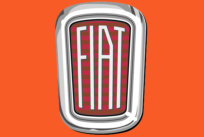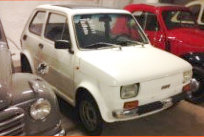
















Nicnamed as Maluch - the small one

Fiat 126 - 1976
The Fiat 126 (Type 126) is a city car introduced in
October 1972 at the Turin Auto Show as a replacement for
the Fiat 500. Some were produced in Bielsko-Biała,
Poland as the Polski Fiat 126p until 2000. It was replaced
by the front-engined Fiat Cinquecento in 1993.
History
The 126 used much of the same mechanical underpinnings and layout as its Fiat 500 rear- engined predecessor with which it shared its wheelbase, but featured an all new bodyshell
engined predecessor with which it shared its wheelbase, but featured an all new bodyshell closely resembling a scaled-down Fiat 127.
closely resembling a scaled-down Fiat 127. Engine capacity was increased from 594 cc to 652 cc at the end of 1977 when the cylinder
Engine capacity was increased from 594 cc to 652 cc at the end of 1977 when the cylinder bore was increased from 73.5 to 77 mm. Claimed power output was unchanged at 23 PS (17
bore was increased from 73.5 to 77 mm. Claimed power output was unchanged at 23 PS (17 kW), but torque was increased from 39 N·m (29 lb·ft) to 43 newton metres (32 lb·ft). The 594
kW), but torque was increased from 39 N·m (29 lb·ft) to 43 newton metres (32 lb·ft). The 594 cc engines were still available in early 1983 production.
cc engines were still available in early 1983 production. A subsequent increase took the engine size to 704 cc in new "restyling" model Fiat 126 Bis
A subsequent increase took the engine size to 704 cc in new "restyling" model Fiat 126 Bis (1987–1991), with 26 PS (19 kW) of motive power.
(1987–1991), with 26 PS (19 kW) of motive power. In Italy, the car was produced in the plants of Cassino and Termini Imerese until 1979. By this
In Italy, the car was produced in the plants of Cassino and Termini Imerese until 1979. By this time 1,352,912 of the cars had been produced in Italy.
time 1,352,912 of the cars had been produced in Italy. The car continued however to be manufactured by FSM in Poland, where it was produced
The car continued however to be manufactured by FSM in Poland, where it was produced from 1973 to 2000 as the Polski Fiat 126p. Even after the introduction of the 126 Bis (a 126p
from 1973 to 2000 as the Polski Fiat 126p. Even after the introduction of the 126 Bis (a 126p with water-cooled 704 cc engine of indigenous Polish construction), the original model
with water-cooled 704 cc engine of indigenous Polish construction), the original model continued to be produced for the Polish market. The car was also produced under licence by
Zastava in Yugoslavia. In 1984, the 126 received a facelift, giving it plastic bumpers (for all
continued to be produced for the Polish market. The car was also produced under licence by
Zastava in Yugoslavia. In 1984, the 126 received a facelift, giving it plastic bumpers (for all versions) and a new dashboard. This model named Fiat 126p FL. In 1994, the 126p received
versions) and a new dashboard. This model named Fiat 126p FL. In 1994, the 126p received another facelift, and some parts from the Fiat Cinquecento, this version was named 126 EL.
another facelift, and some parts from the Fiat Cinquecento, this version was named 126 EL. The 126 ELX introduced a catalytic converter.
Despite clever marketing, the 126 never achieved the frenzied popularity of the 500. The
The 126 ELX introduced a catalytic converter.
Despite clever marketing, the 126 never achieved the frenzied popularity of the 500. The total number of 126 produced is: 1,352,912 in Italy, 3,318,674 in Poland, 2,069 in Austria,
total number of 126 produced is: 1,352,912 in Italy, 3,318,674 in Poland, 2,069 in Austria, and an unknown number in Yugoslavia. For a brief period in the early 1990s, a German
and an unknown number in Yugoslavia. For a brief period in the early 1990s, a German company called POP also offered convertible versions of the 126 BIS. Two models were
company called POP also offered convertible versions of the 126 BIS. Two models were offered: a lesser equipped one called the "POP 650" and a more luxurious model called the
offered: a lesser equipped one called the "POP 650" and a more luxurious model called the "POP 2000".
"POP 2000".
Polski Fiat 126p
The car was produced in Poland under the brand Polski Fiat 126p (literally in English: Polish Fiat 126p) between 1973 and 2000. At first it was almost identical with the basic model:
Fiat 126p) between 1973 and 2000. At first it was almost identical with the basic model: differences included a higher chassis, a modified grille on the back, and the front blinkers
differences included a higher chassis, a modified grille on the back, and the front blinkers that were white in Italy but orange for other markets. To distinguish it from the original
that were white in Italy but orange for other markets. To distinguish it from the original Italian car, the letter "p" was added to its name. It was produced by Fabryka Samochodów
Italian car, the letter "p" was added to its name. It was produced by Fabryka Samochodów Małolitrażowych (FSM) in Bielsko-Biała and Tychy under Italian Fiat licence. Throughout the
Małolitrażowych (FSM) in Bielsko-Biała and Tychy under Italian Fiat licence. Throughout the 1980s the 126p was continuously modified. First it received upgraded brakes and new wheels
1980s the 126p was continuously modified. First it received upgraded brakes and new wheels from Italian Fiat, hazard blinkers were added to meet new law requirements, in 1985 tail fog
from Italian Fiat, hazard blinkers were added to meet new law requirements, in 1985 tail fog light and factory back-up light were added to then standard plastic bumpers, an electronic
light and factory back-up light were added to then standard plastic bumpers, an electronic ignition system and alternator replaced undersized generator around 1987. The factory
ignition system and alternator replaced undersized generator around 1987. The factory battery in 126p had only 35 Amp-hour capacity which combined with undersized generator
battery in 126p had only 35 Amp-hour capacity which combined with undersized generator resulted in never fully charged battery unless someone drove the car without stopping for
resulted in never fully charged battery unless someone drove the car without stopping for extended time period. Some owners upgraded to a 45 Amp-hour battery from Fiat 125p (1.5
extended time period. Some owners upgraded to a 45 Amp-hour battery from Fiat 125p (1.5 Liter engine) to improve the cold start reliability. Due to a relatively low price it was very
Liter engine) to improve the cold start reliability. Due to a relatively low price it was very popular in Poland and was arguably the most popular car there in the 1980s. Its very small
popular in Poland and was arguably the most popular car there in the 1980s. Its very small size gave it the nickname maluch ("the small one","small child"). The nickname became so
size gave it the nickname maluch ("the small one","small child"). The nickname became so popular that in 1997 it was accepted by the producer as the official name of the car.
It was exported to many Eastern Bloc countries and for several years it was one of the most
popular that in 1997 it was accepted by the producer as the official name of the car.
It was exported to many Eastern Bloc countries and for several years it was one of the most popular cars in Poland and in Hungary as well. It also found a minor market in Australia
popular cars in Poland and in Hungary as well. It also found a minor market in Australia between 1989 and 1992, under the name FSM Niki. During that period it was Australia's
between 1989 and 1992, under the name FSM Niki. During that period it was Australia's cheapest car. There was a convertible version developed for Australian market.
Throughout the 1980s there were several experimental prototypes developed in Poland. A
cheapest car. There was a convertible version developed for Australian market.
Throughout the 1980s there were several experimental prototypes developed in Poland. A cargo version called "Bombel" ("a bubble") for its fiberglass bubble shaped cargo enclosure,
cargo version called "Bombel" ("a bubble") for its fiberglass bubble shaped cargo enclosure, an off road version propelled by caterpillar tracks and a front wheel drive, front engine, with
an off road version propelled by caterpillar tracks and a front wheel drive, front engine, with longer front end and flat cargo area in the rear where the original 126 had engine. The rear
longer front end and flat cargo area in the rear where the original 126 had engine. The rear of this prototype was similar to the 126 Bis which also had a rear hatch for accessing the
of this prototype was similar to the 126 Bis which also had a rear hatch for accessing the cargo space above the flat water cooled engine hidden in the floor. There was also an
cargo space above the flat water cooled engine hidden in the floor. There was also an attempt at installing a small diesel engine (due to gasoline rationing) in the classic 126p
attempt at installing a small diesel engine (due to gasoline rationing) in the classic 126p body.
body.

1976
 Engine
499 cc
2 cylinders
Power
18 HP
Lenght/width
2,97 m/1,32 m
Weight
520 kg
Engine
499 cc
2 cylinders
Power
18 HP
Lenght/width
2,97 m/1,32 m
Weight
520 kg
 The collections 126 is probably the
only officially imported with
sunroof. This Fiat served as our
ticket bakc to home when we
delivered one of our Showroom
buses to any loocation in Europe.
Fiat could be parked inside the bus.
The collections 126 is probably the
only officially imported with
sunroof. This Fiat served as our
ticket bakc to home when we
delivered one of our Showroom
buses to any loocation in Europe.
Fiat could be parked inside the bus.



Photos mainly by Matti Kreivilä. Historical facts and technical details of the vehicles provided by Wikipedia. Movies YouTube.













